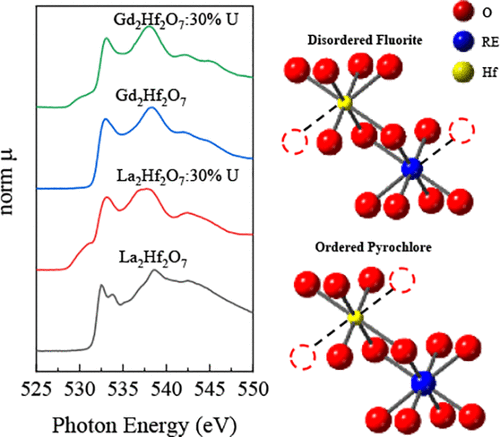当前位置:
X-MOL 学术
›
Inorg. Chem.
›
论文详情
Our official English website, www.x-mol.net, welcomes your feedback! (Note: you will need to create a separate account there.)
Effect of Oxide Ion Distribution on a Uranium Structure in Highly U-Doped RE2Hf2O7 (RE = La and Gd) Nanoparticles.
Inorganic Chemistry ( IF 4.6 ) Pub Date : 2020-09-22 , DOI: 10.1021/acs.inorgchem.0c01850 Yuming Wang 1 , Pragathi Darapaneni 1 , Tochukwu Ofoegbuna 1 , Santosh K Gupta 2 , Orhan Kizilkaya 3 , Yuanbing Mao 4 , James A Dorman 1
Inorganic Chemistry ( IF 4.6 ) Pub Date : 2020-09-22 , DOI: 10.1021/acs.inorgchem.0c01850 Yuming Wang 1 , Pragathi Darapaneni 1 , Tochukwu Ofoegbuna 1 , Santosh K Gupta 2 , Orhan Kizilkaya 3 , Yuanbing Mao 4 , James A Dorman 1
Affiliation

|
Rare-earth based A2B2O7 compounds have been considered as potential host materials for nuclear waste due to their exceptional chemical, physical, capability of accommodating high concentration of actinides at both A- and B-sites, negligible leaching, tendency to form antisite defects, and radiation stabilities. In this work, La2Hf2O7 (LHO) and Gd2Hf2O7 (GHO) nanoparticles (NPs) were chosen as the RE-based hafnates to study the structural changes and the formation of different U molecular structures upon doping (or alloying) at high concentration (up to 30 mol %) using a combined coprecipitation and molten-salt synthesis. These compounds form similar crystal structures, i.e., ordered pyrochlore (LHO) and disordered fluorite (GHO), but are expected to show different phase transformations at high U doping concentration. X-ray diffraction (XRD) and Rietveld refinement results show that the LHO:U NPs have high structural stability, whereas the GHO:U NPs exhibit a highly disordered structure at high U concentration. Alternatively, the vibrational spectra show an increasingly random oxygen distribution with U doping, driving the LHO:U NPs to the disordered fluorite phase. X-ray spectroscopy indicates that U is stabilized as different U6+ species in both LHO and GHO hosts, resulting in the formation of oxygen vacancies stemming from the U local coordination and different phase transformation. Interestingly, the disordered fluorite phase has been reported to have increased radiation tolerance, suggesting multiple benefits associated with the LHO host. These results demonstrate the importance of the structural and chemical effect of actinide dopants on similar host matrices which are important for the development of RE-based hafnates for nuclear waste hosts, sensors, thermal barrier coatings, and scintillator applications.
中文翻译:

氧离子分布对高U掺杂RE2Hf2O7(RE = La和Gd)纳米粒子中铀结构的影响。
稀土基A 2 B 2 O 7化合物由于其优异的化学,物理,在A和B位置都能容纳高浓度的act系元素,可忽略不计的浸出,易于分解的趋势而被认为是潜在的核废料宿主材料。形成反位缺陷和辐射稳定性。在这项工作中,La 2 Hf 2 O 7(LHO)和Gd 2 Hf 2 O 7(GHO)纳米粒子(NPs)被选作RE基的Hafnates,以结合共沉淀和熔融的方式研究高浓度(最高30 mol%)掺杂(或合金化)后的结构变化和不同U分子结构的形成盐合成。这些化合物形成相似的晶体结构,即有序烧绿石(LHO)和无序萤石(GHO),但在高U掺杂浓度下会显示出不同的相变。X射线衍射(XRD)和Rietveld精修结果表明LHO:U NPs具有较高的结构稳定性,而GHO:U NPs在高U浓度下具有高度无序的结构。另外,振动光谱显示,随着U掺杂,氧气分布越来越随机,从而将LHO:U NPs驱动到无序萤石相。LHO和GHO宿主中都有6+种,导致形成了U局部配位和不同相变引起的氧空位。有趣的是,据报道无序的萤石相具有更高的辐射耐受性,表明与LHO宿主相关的多种益处。这些结果证明了act系元素掺杂剂对类似基质基质的结构和化学作用的重要性,这对于开发用于核废料基质,传感器,热障涂层和闪烁体应用的基于RE的盐酸盐非常重要。
更新日期:2020-10-05
中文翻译:

氧离子分布对高U掺杂RE2Hf2O7(RE = La和Gd)纳米粒子中铀结构的影响。
稀土基A 2 B 2 O 7化合物由于其优异的化学,物理,在A和B位置都能容纳高浓度的act系元素,可忽略不计的浸出,易于分解的趋势而被认为是潜在的核废料宿主材料。形成反位缺陷和辐射稳定性。在这项工作中,La 2 Hf 2 O 7(LHO)和Gd 2 Hf 2 O 7(GHO)纳米粒子(NPs)被选作RE基的Hafnates,以结合共沉淀和熔融的方式研究高浓度(最高30 mol%)掺杂(或合金化)后的结构变化和不同U分子结构的形成盐合成。这些化合物形成相似的晶体结构,即有序烧绿石(LHO)和无序萤石(GHO),但在高U掺杂浓度下会显示出不同的相变。X射线衍射(XRD)和Rietveld精修结果表明LHO:U NPs具有较高的结构稳定性,而GHO:U NPs在高U浓度下具有高度无序的结构。另外,振动光谱显示,随着U掺杂,氧气分布越来越随机,从而将LHO:U NPs驱动到无序萤石相。LHO和GHO宿主中都有6+种,导致形成了U局部配位和不同相变引起的氧空位。有趣的是,据报道无序的萤石相具有更高的辐射耐受性,表明与LHO宿主相关的多种益处。这些结果证明了act系元素掺杂剂对类似基质基质的结构和化学作用的重要性,这对于开发用于核废料基质,传感器,热障涂层和闪烁体应用的基于RE的盐酸盐非常重要。


























 京公网安备 11010802027423号
京公网安备 11010802027423号